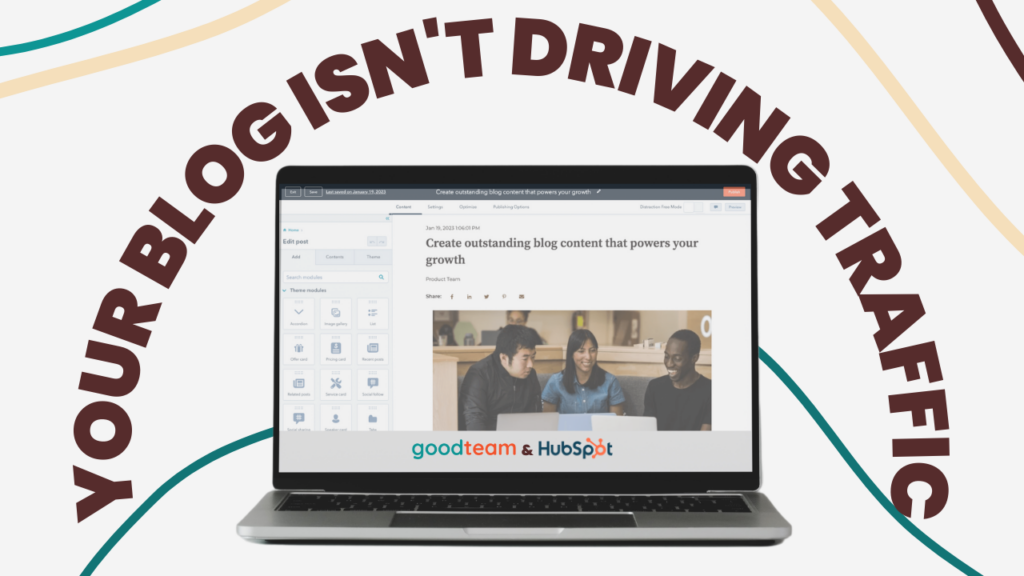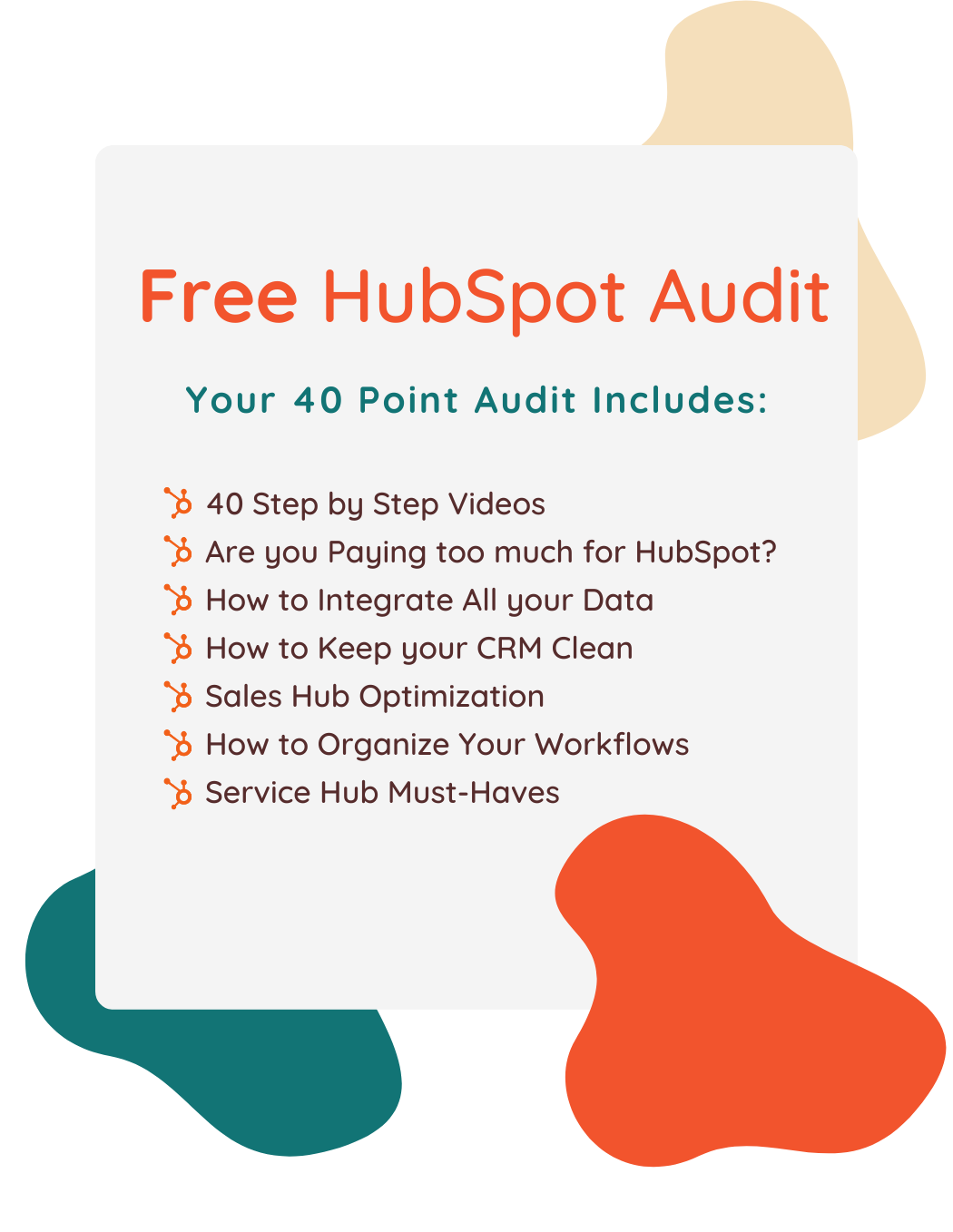10 Reasons Your Blog Isn’t Driving Traffic to Your Website (And How HubSpot Can Help)

Written by
Good Team
Created on
July 14, 2023
10 Reasons Your Blog Isn’t Driving Traffic to Your Website (And How HubSpot Can Help)
Creating content that will show your expertise, engage with your target audience, and drive traffic to your website is crucial for a successful online business.
But despite investing time and effort into creating valuable content, are you struggling to drive traffic to your website?
You’re not alone!
By the end of this article, you’ll know the top ten most common reasons why your blog might not be driving the desired traffic to your website.
And how HubSpot can help you overcome these problems and supercharge your blogging efforts.
1. Lack of Keyword Research:
One of the main reasons your blog may not be generating traffic is a lack of keyword research.
Keywords are essential for search engine optimization (SEO) and help search engines understand the context of your content.
You could create the best content in the world, but if people can’t find in on Google or other search engines, it’s going to bring in traffic to your website.
Here’s how HubSpot can help:
HubSpot provides powerful SEO tools that enable you to identify relevant keywords and optimize your blog posts for higher search rankings.
2. Inconsistent Content Quality:
Consistency is key when it comes to blogging.
If your blog posts lack quality, relevance, or fail to provide value to your readers, they won’t engage with your content or share it with others.
HubSpot’s content strategy tools can help you plan and create high-quality, informative blog posts that resonate with your audience and encourage them to return for more.
3. Absence of a Promotional Strategy:
Creating great content is only half the battle; promoting it effectively is equally as important.
Because without a solid promotional strategy, your blog posts might get lost in the sea of online content.
Luckily, HubSpot’s marketing automation tools allow you to automate your blog post promotion, reaching your target audience through various channels like social media, email, and more.
4. Ignoring Social Media Channels:
Social media platforms are a goldmine for driving traffic to your blog.
If you are not leveraging the power of platforms like Facebook, Twitter, LinkedIn, and Instagram, you are missing out on a massive potential audience.
HubSpot’s social media management tools can help you streamline your social media presence, schedule posts, engage with your followers, and ultimately drive traffic back to your blog.
5. Lack of Consistent Posting Schedule:
Not only should you use social media, but you should also be consistent.
For example, if someone follows you on social media and your audience doesn’t know when to expect new content, they may lose interest or forget about you.
Again, you can use HubSpot’s social media management tools to plan and schedule your posts in advance, ensuring a consistent flow of fresh content for your audience.
6. Poor Website Design and User Experience:
Your blog may suffer from low traffic if your website has a poor design or offers a subpar user experience.
For example, slow page loading times, cluttered layouts, and complicated navigation can discourage visitors from exploring your content.
Luckily, HubSpot’s website builder provides a range of templates and tools to create visually appealing, user-friendly websites that enhance the overall experience for your visitors.
7. Neglecting SEO Optimization:
Effective search engine optimization is vital to increasing your blog’s visibility and driving organic traffic.
Neglecting essential SEO elements such as meta tags, headings, alt text, and internal linking can significantly impact your blog’s search engine rankings.
And to help you out, HubSpot’s SEO tools offer insights and recommendations to optimize your blog posts, making them more discoverable to search engines.
8. Lack of Internal and External Linking:
You might not know this, but internal and external linking within your blog posts can greatly enhance their SEO value.
Internal links guide readers to other relevant content on your website, increasing engagement and session duration.
External links to authoritative sources help establish your credibility and improve search engine rankings.
HubSpot’s topic cluster tool helps you identify opportunities for effective linking within your blog posts.
9. Absence of Call-to-Actions (CTAs):
You might be avoiding CTAs on your website because you don’t want to sound “salesy” or “pushy”. But let me assure you, CTAs are something that should never be ignored.
CTAs guide readers to take the desired actions, such as subscribing to your newsletter, downloading a resource, or exploring your products or services.
Have you ever been to a website where you’re ready to buy, but you can’t figure out how?
That’s a sure way to lose customers.
So, to help with that, HubSpot’s CTA creation tools allow you to design eye-catching CTAs that motivate your readers to engage further with your brand.
10. Inadequate Monitoring and Analytics:
And last but not least, analytics.
Without proper tracking and analysis, it’s almost impossible to understand how your blog is performing and identify areas for improvement.
But thankfully, HubSpot’s robust analytics and reporting features provide valuable insights into your blog’s traffic, audience engagement, and conversion rates.
With this data, you can make informed decisions to optimize your blog strategy and drive more traffic to your website.
And that’s it!
All in all, if your blog isn’t generating the desired traffic, it’s time to take a step back and evaluate your approach.
By addressing the ten reasons mentioned above and utilizing HubSpot’s comprehensive suite of tools and resources, you can transform your blog into a traffic-driving machine.
Remember, content marketing isn’t successful overnight, but with persistence, valuable content, and the right tools at your disposal, you can significantly increase your website traffic and achieve your goals.
Want to learn more about how to use HubSpot? Great! We’d love to help.
Get Your Free DIY 40-Point HubSpot Audit with Videos!

